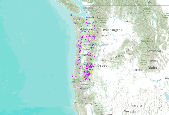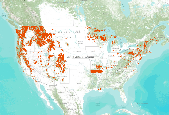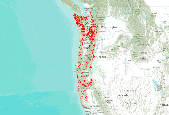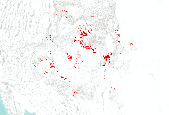|
|

This dataset is a compilation of forest insect, disease and abiotic damage mapped by aerial detection surveys on forested areas in the United States. At this time, the National Aerial Survey Data Standards require only mortality and defoliation data be collected and reported. However, many cooperators collect data on other types of damage and therefore, the national database has been designed to accommodate these data. Low-level flights, typically 1,000 to 2,000 feet above ground level, are used to map forest damage. Observers use paper maps, typically 1:100,000 scale USGS maps, upon which they record the damage. There is also a digital sketchmap system that may be used. The digital system uses GPS to display the...
Tags: aerial survey,
condition,
damage,
defoliation,
dieback, All tags...
disease,
forest condition,
forest health,
health,
insect,
insect outbreaks,
insect populations,
national forest,
sketch map,
topkill,
tree mortatlity,
tree stress, Fewer tags

This dataset is a compilation of forest insect, disease and abiotic damage mapped by aerial detection surveys on forested areas in the United States. At this time, the National Aerial Survey Data Standards require only mortality and defoliation data be collected and reported. However, many cooperators collect data on other types of damage and therefore, the national database has been designed to accommodate these data. Low-level flights, typically 1,000 to 2,000 feet above ground level, are used to map forest damage. Observers use paper maps, typically 1:100,000 scale USGS maps, upon which they record the damage. There is also a digital sketchmap system that may be used. The digital system uses GPS to display the...
Tags: aerial survey,
condition,
damage,
defoliation,
dieback, All tags...
disease,
forest condition,
forest health,
health,
insect,
insect outbreaks,
insect populations,
national forest,
sketch map,
topkill,
tree mortatlity,
tree stress, Fewer tags

This dataset is a compilation of forest insect, disease and abiotic damage mapped by aerial detection surveys on forested areas in the United States. At this time, the National Aerial Survey Data Standards require only mortality and defoliation data be collected and reported. However, many cooperators collect data on other types of damage and therefore, the national database has been designed to accommodate these data. Low-level flights, typically 1,000 to 2,000 feet above ground level, are used to map forest damage. Observers use paper maps, typically 1:100,000 scale USGS maps, upon which they record the damage. There is also a digital sketchmap system that may be used. The digital system uses GPS to display the...
Tags: aerial survey,
condition,
damage,
defoliation,
dieback, All tags...
disease,
forest condition,
forest health,
health,
insect,
insect outbreaks,
insect populations,
national forest,
sketch map,
topkill,
tree mortatlity,
tree stress, Fewer tags

This dataset is a compilation of forest insect, disease and abiotic damage mapped by aerial detection surveys on forested areas in the United States. At this time, the National Aerial Survey Data Standards require only mortality and defoliation data be collected and reported. However, many cooperators collect data on other types of damage and therefore, the national database has been designed to accommodate these data. Low-level flights, typically 1,000 to 2,000 feet above ground level, are used to map forest damage. Observers use paper maps, typically 1:100,000 scale USGS maps, upon which they record the damage. There is also a digital sketchmap system that may be used. The digital system uses GPS to display the...
Tags: aerial survey,
condition,
damage,
defoliation,
dieback, All tags...
disease,
forest condition,
forest health,
health,
insect,
insect outbreaks,
insect populations,
national forest,
sketch map,
topkill,
tree mortatlity,
tree stress, Fewer tags

This dataset is a compilation of forest insect, disease and abiotic damage mapped by aerial detection surveys on forested areas in the United States. At this time, the National Aerial Survey Data Standards require only mortality and defoliation data be collected and reported. However, many cooperators collect data on other types of damage and therefore, the national database has been designed to accommodate these data. Low-level flights, typically 1,000 to 2,000 feet above ground level, are used to map forest damage. Observers use paper maps, typically 1:100,000 scale USGS maps, upon which they record the damage. There is also a digital sketchmap system that may be used. The digital system uses GPS to display the...
Tags: aerial survey,
condition,
damage,
defoliation,
dieback, All tags...
disease,
forest condition,
forest health,
health,
insect,
insect outbreaks,
insect populations,
national forest,
sketch map,
topkill,
tree mortatlity,
tree stress, Fewer tags

This dataset is a compilation of forest insect, disease and abiotic damage mapped by aerial detection surveys on forested areas in the United States. At this time, the National Aerial Survey Data Standards require only mortality and defoliation data be collected and reported. However, many cooperators collect data on other types of damage and therefore, the national database has been designed to accommodate these data. Low-level flights, typically 1,000 to 2,000 feet above ground level, are used to map forest damage. Observers use paper maps, typically 1:100,000 scale USGS maps, upon which they record the damage. There is also a digital sketchmap system that may be used. The digital system uses GPS to display the...
Tags: aerial survey,
condition,
damage,
defoliation,
dieback, All tags...
disease,
forest condition,
forest health,
health,
insect,
insect outbreaks,
insect populations,
national forest,
sketch map,
topkill,
tree mortatlity,
tree stress, Fewer tags

This dataset is a compilation of forest insect, disease and abiotic damage mapped by aerial detection surveys on forested areas in the United States. At this time, the National Aerial Survey Data Standards require only mortality and defoliation data be collected and reported. However, many cooperators collect data on other types of damage and therefore, the national database has been designed to accommodate these data. Low-level flights, typically 1,000 to 2,000 feet above ground level, are used to map forest damage. Observers use paper maps, typically 1:100,000 scale USGS maps, upon which they record the damage. There is also a digital sketchmap system that may be used. The digital system uses GPS to display the...
Tags: aerial survey,
condition,
damage,
defoliation,
dieback, All tags...
disease,
forest condition,
forest health,
health,
insect,
insect outbreaks,
insect populations,
national forest,
sketch map,
topkill,
tree mortatlity,
tree stress, Fewer tags

This dataset is a compilation of forest insect, disease and abiotic damage mapped by aerial detection surveys on forested areas in the United States. At this time, the National Aerial Survey Data Standards require only mortality and defoliation data be collected and reported. However, many cooperators collect data on other types of damage and therefore, the national database has been designed to accommodate these data. Low-level flights, typically 1,000 to 2,000 feet above ground level, are used to map forest damage. Observers use paper maps, typically 1:100,000 scale USGS maps, upon which they record the damage. There is also a digital sketchmap system that may be used. The digital system uses GPS to display the...
Tags: aerial survey,
condition,
damage,
defoliation,
dieback, All tags...
disease,
forest condition,
forest health,
health,
insect,
insect outbreaks,
insect populations,
national forest,
sketch map,
topkill,
tree mortatlity,
tree stress, Fewer tags

This dataset is a compilation of forest insect, disease and abiotic damage mapped by aerial detection surveys on forested areas in the United States. At this time, the National Aerial Survey Data Standards require only mortality and defoliation data be collected and reported. However, many cooperators collect data on other types of damage and therefore, the national database has been designed to accommodate these data. Low-level flights, typically 1,000 to 2,000 feet above ground level, are used to map forest damage. Observers use paper maps, typically 1:100,000 scale USGS maps, upon which they record the damage. There is also a digital sketchmap system that may be used. The digital system uses GPS to display the...
Tags: aerial survey,
condition,
damage,
defoliation,
dieback, All tags...
disease,
forest condition,
forest health,
health,
insect,
insect outbreaks,
insect populations,
national forest,
sketch map,
topkill,
tree mortatlity,
tree stress, Fewer tags

This dataset is a compilation of forest insect, disease and abiotic damage mapped by aerial detection surveys on forested areas in the United States. At this time, the National Aerial Survey Data Standards require only mortality and defoliation data be collected and reported. However, many cooperators collect data on other types of damage and therefore, the national database has been designed to accommodate these data. Low-level flights, typically 1,000 to 2,000 feet above ground level, are used to map forest damage. Observers use paper maps, typically 1:100,000 scale USGS maps, upon which they record the damage. There is also a digital sketchmap system that may be used. The digital system uses GPS to display the...
Tags: aerial survey,
condition,
damage,
defoliation,
dieback, All tags...
disease,
forest condition,
forest health,
health,
insect,
insect outbreaks,
insect populations,
national forest,
sketch map,
topkill,
tree mortatlity,
tree stress, Fewer tags

This dataset is a compilation of forest insect, disease and abiotic damage mapped by aerial detection surveys on forested areas in the United States. At this time, the National Aerial Survey Data Standards require only mortality and defoliation data be collected and reported. However, many cooperators collect data on other types of damage and therefore, the national database has been designed to accommodate these data. Low-level flights, typically 1,000 to 2,000 feet above ground level, are used to map forest damage. Observers use paper maps, typically 1:100,000 scale USGS maps, upon which they record the damage. There is also a digital sketchmap system that may be used. The digital system uses GPS to display the...
Tags: aerial survey,
condition,
damage,
defoliation,
dieback, All tags...
disease,
forest condition,
forest health,
health,
insect,
insect outbreaks,
insect populations,
national forest,
sketch map,
topkill,
tree mortatlity,
tree stress, Fewer tags

This dataset is a compilation of forest insect, disease and abiotic damage mapped by aerial detection surveys on forested areas in the United States. At this time, the National Aerial Survey Data Standards require only mortality and defoliation data be collected and reported. However, many cooperators collect data on other types of damage and therefore, the national database has been designed to accommodate these data. Low-level flights, typically 1,000 to 2,000 feet above ground level, are used to map forest damage. Observers use paper maps, typically 1:100,000 scale USGS maps, upon which they record the damage. There is also a digital sketchmap system that may be used. The digital system uses GPS to display the...
Tags: aerial survey,
condition,
damage,
defoliation,
dieback, All tags...
disease,
forest condition,
forest health,
health,
insect,
insect outbreaks,
insect populations,
national forest,
sketch map,
topkill,
tree mortatlity,
tree stress, Fewer tags

This dataset is a compilation of forest insect, disease and abiotic damage mapped by aerial detection surveys on forested areas in the United States. At this time, the National Aerial Survey Data Standards require only mortality and defoliation data be collected and reported. However, many cooperators collect data on other types of damage and therefore, the national database has been designed to accommodate these data. Low-level flights, typically 1,000 to 2,000 feet above ground level, are used to map forest damage. Observers use paper maps, typically 1:100,000 scale USGS maps, upon which they record the damage. There is also a digital sketchmap system that may be used. The digital system uses GPS to display the...
Tags: aerial survey,
condition,
damage,
defoliation,
dieback, All tags...
disease,
forest condition,
forest health,
health,
insect,
insect outbreaks,
insect populations,
national forest,
sketch map,
topkill,
tree mortatlity,
tree stress, Fewer tags

This dataset is a compilation of forest insect, disease and abiotic damage mapped by aerial detection surveys on forested areas in the United States. At this time, the National Aerial Survey Data Standards require only mortality and defoliation data be collected and reported. However, many cooperators collect data on other types of damage and therefore, the national database has been designed to accommodate these data. Low-level flights, typically 1,000 to 2,000 feet above ground level, are used to map forest damage. Observers use paper maps, typically 1:100,000 scale USGS maps, upon which they record the damage. There is also a digital sketchmap system that may be used. The digital system uses GPS to display the...
Tags: aerial survey,
condition,
damage,
defoliation,
dieback, All tags...
disease,
forest condition,
forest health,
health,
insect,
insect outbreaks,
insect populations,
national forest,
sketch map,
topkill,
tree mortatlity,
tree stress, Fewer tags

Since 1999, the B.C. Ministry of Forests has surveyed the majority of the forested land in the province using the classic sketch mapping technique known as the the overview survey method. The purpose of the survey is to record and report the general trends in disturbance patterns across the provincial forested land base (including provincial parks, private land, and Tree Farm Licences but not Federal parks). The survey has been a key source of data documenting the development of the current mountain pine beetle outbreak in the interior of B.C. Data from the BC MOF survey is also comparable to data collected from 1914 to 1995 by the Canadian Forest Service's former Forest Insect and Disease Survey Unit (FIDS)...
Tags: aerial survey,
condition,
damage,
defoliation,
dieback, All tags...
disease,
forest condition,
forest health,
health,
insect,
insect outbreaks,
insect populations,
national forest,
sketch map,
topkill,
tree mortatlity,
tree stress, Fewer tags

This dataset is a union of seven datasets created by the Merriam-Powell Center for Environmental Research (MPCER) at Northern Arizona University using data from a a United States Forest Service (USFS) aerial mapping project. The dataset was modified by selecting individual species from the USFS data. The original USFS dataset is a compilation of forest insect, disease and abiotic damage mapped by aerial detection surveys on forested areas in the United States. At this time, the National Aerial Survey Data Standards require only mortality and defoliation data be collected and reported. However, many cooperators collect data on other types of damage and therefore, the national database has been designed to accommodate...
Tags: aerial survey,
condition,
damage,
defoliation,
dieback, All tags...
disease,
envrionment,
forest condition,
forest health,
health,
insect,
insect outbreaks,
insect populations,
national forest,
sketch map,
topkill,
tree mortatlity,
tree stress, Fewer tags

This dataset is a compilation of forest insect, disease and abiotic damage mapped by aerial detection surveys on forested areas in the United States. At this time, the National Aerial Survey Data Standards require only mortality and defoliation data be collected and reported. However, many cooperators collect data on other types of damage and therefore, the national database has been designed to accommodate these data. Low-level flights, typically 1,000 to 2,000 feet above ground level, are used to map forest damage. Observers use paper maps, typically 1:100,000 scale USGS maps, upon which they record the damage. There is also a digital sketchmap system that may be used. The digital system uses GPS to display the...
Tags: aerial survey,
condition,
damage,
defoliation,
dieback, All tags...
disease,
forest condition,
forest health,
health,
insect,
insect outbreaks,
insect populations,
national forest,
sketch map,
topkill,
tree mortatlity,
tree stress, Fewer tags

This dataset is a compilation of forest insect, disease and abiotic damage mapped by aerial detection surveys on forested areas in the United States. At this time, the National Aerial Survey Data Standards require only mortality and defoliation data be collected and reported. However, many cooperators collect data on other types of damage and therefore, the national database has been designed to accommodate these data. Low-level flights, typically 1,000 to 2,000 feet above ground level, are used to map forest damage. Observers use paper maps, typically 1:100,000 scale USGS maps, upon which they record the damage. There is also a digital sketchmap system that may be used. The digital system uses GPS to display the...
Tags: aerial survey,
condition,
damage,
defoliation,
dieback, All tags...
disease,
forest condition,
forest health,
health,
insect,
insect outbreaks,
insect populations,
national forest,
sketch map,
topkill,
tree mortatlity,
tree stress, Fewer tags

This dataset is a compilation of forest insect, disease and abiotic damage mapped by aerial detection surveys on forested areas in the United States. At this time, the National Aerial Survey Data Standards require only mortality and defoliation data be collected and reported. However, many cooperators collect data on other types of damage and therefore, the national database has been designed to accommodate these data. Low-level flights, typically 1,000 to 2,000 feet above ground level, are used to map forest damage. Observers use paper maps, typically 1:100,000 scale USGS maps, upon which they record the damage. There is also a digital sketchmap system that may be used. The digital system uses GPS to display the...
Tags: aerial survey,
condition,
damage,
defoliation,
dieback, All tags...
disease,
forest condition,
forest health,
health,
insect,
insect outbreaks,
insect populations,
national forest,
sketch map,
topkill,
tree mortatlity,
tree stress, Fewer tags

This dataset is a compilation of forest insect, disease and abiotic damage mapped by aerial detection surveys on forested areas in the United States. At this time, the National Aerial Survey Data Standards require only mortality and defoliation data be collected and reported. However, many cooperators collect data on other types of damage and therefore, the national database has been designed to accommodate these data. Low-level flights, typically 1,000 to 2,000 feet above ground level, are used to map forest damage. Observers use paper maps, typically 1:100,000 scale USGS maps, upon which they record the damage. There is also a digital sketchmap system that may be used. The digital system uses GPS to display the...
Tags: aerial survey,
condition,
damage,
defoliation,
dieback, All tags...
disease,
forest condition,
forest health,
health,
insect,
insect outbreaks,
insect populations,
national forest,
sketch map,
topkill,
tree mortatlity,
tree stress, Fewer tags
|
|